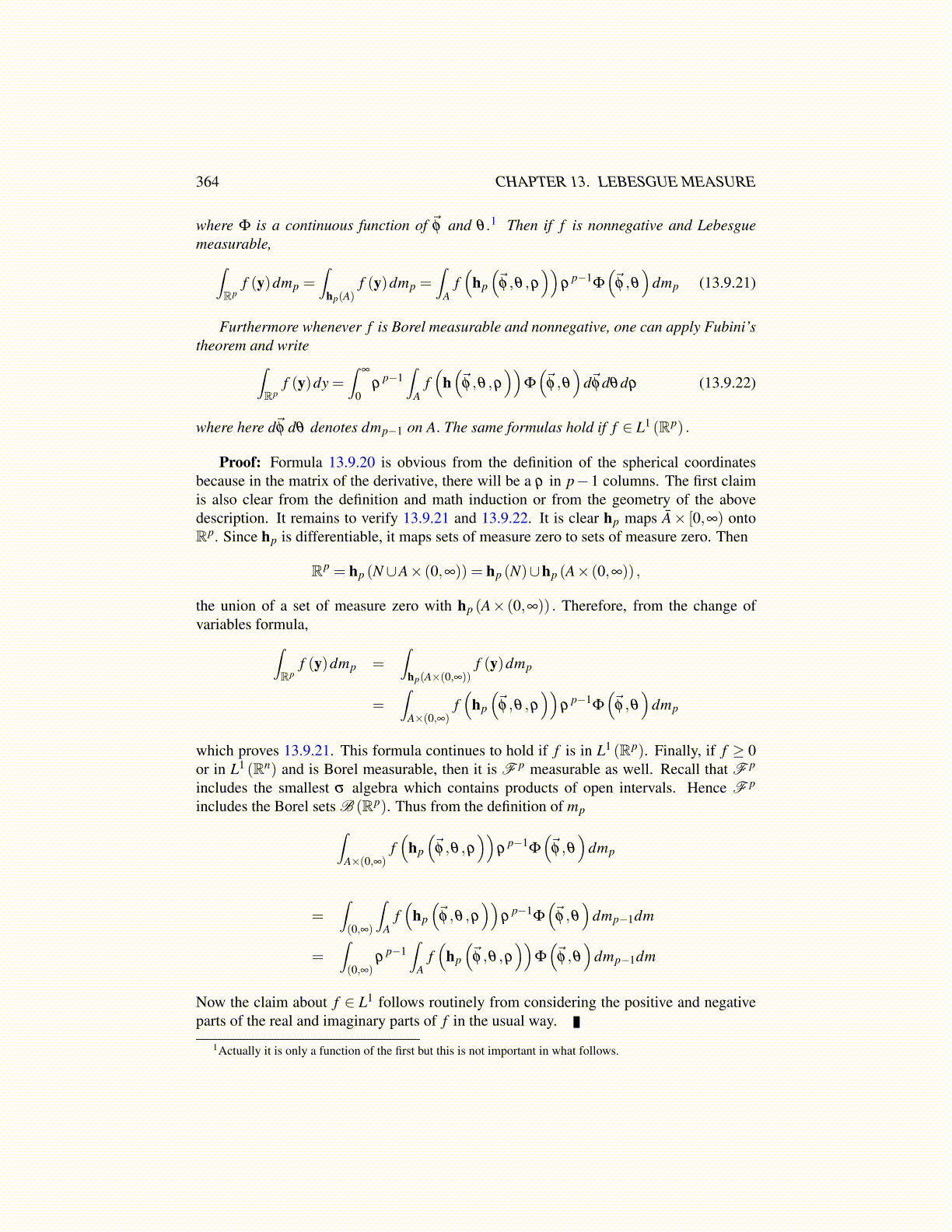
364 CHAPTER 13. LEBESGUE MEASURE
where Φ is a continuous function of φ⃗ and θ .1 Then if f is nonnegative and Lebesguemeasurable,∫
Rpf (y)dmp =
∫hp(A)
f (y)dmp =∫
Af(
hp
(⃗φ ,θ ,ρ
))ρ
p−1Φ
(⃗φ ,θ
)dmp (13.9.21)
Furthermore whenever f is Borel measurable and nonnegative, one can apply Fubini’stheorem and write∫
Rpf (y)dy =
∫∞
0ρ
p−1∫
Af(
h(⃗
φ ,θ ,ρ))
Φ
(⃗φ ,θ
)dφ⃗dθdρ (13.9.22)
where here dφ⃗ dθ denotes dmp−1 on A. The same formulas hold if f ∈ L1 (Rp) .
Proof: Formula 13.9.20 is obvious from the definition of the spherical coordinatesbecause in the matrix of the derivative, there will be a ρ in p−1 columns. The first claimis also clear from the definition and math induction or from the geometry of the abovedescription. It remains to verify 13.9.21 and 13.9.22. It is clear hp maps Ā× [0,∞) ontoRp. Since hp is differentiable, it maps sets of measure zero to sets of measure zero. Then
Rp = hp (N∪A× (0,∞)) = hp (N)∪hp (A× (0,∞)) ,
the union of a set of measure zero with hp (A× (0,∞)) . Therefore, from the change ofvariables formula,∫
Rpf (y)dmp =
∫hp(A×(0,∞))
f (y)dmp
=∫
A×(0,∞)f(
hp
(⃗φ ,θ ,ρ
))ρ
p−1Φ
(⃗φ ,θ
)dmp
which proves 13.9.21. This formula continues to hold if f is in L1 (Rp). Finally, if f ≥ 0or in L1 (Rn) and is Borel measurable, then it is F p measurable as well. Recall that F p
includes the smallest σ algebra which contains products of open intervals. Hence F p
includes the Borel sets B (Rp). Thus from the definition of mp∫A×(0,∞)
f(
hp
(⃗φ ,θ ,ρ
))ρ
p−1Φ
(⃗φ ,θ
)dmp
=∫(0,∞)
∫A
f(
hp
(⃗φ ,θ ,ρ
))ρ
p−1Φ
(⃗φ ,θ
)dmp−1dm
=∫(0,∞)
ρp−1
∫A
f(
hp
(⃗φ ,θ ,ρ
))Φ
(⃗φ ,θ
)dmp−1dm
Now the claim about f ∈ L1 follows routinely from considering the positive and negativeparts of the real and imaginary parts of f in the usual way.
1Actually it is only a function of the first but this is not important in what follows.